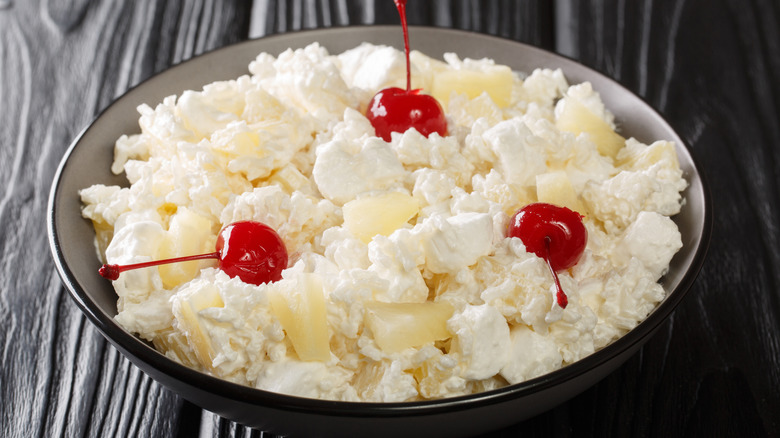The Midwestern Marshmallow Comfort Food That Seems To Have Vanished
Ah, the 1930s — a time of truly tremendous highs and terrible lows. Back then, Shirley Temple was huge, the Great Depression had thrust the world into scarcity, and you practically couldn't show up at a church potluck or holiday get-together without encountering at least one bowl of a dish known as glorified rice — at least in the United States.
Made of canned fruit (typically pineapple, and sometimes maraschino cherries — just like the kind that topped a Roy Rogers or Shirley Temple), whipped cream (and later, Cool Whip), chilled rice, and optional mini marshmallows, it was a sweet, gloppy concoction of a dessert — excuse us, salad — that started gaining popularity in the '30s and had a true heyday all the way into the '70s and '80s. Eventually, it fell out of fashion as public health trends shifted toward whole foods and away from processed ingredients and artificially colored foods.
@bdylanhollis
You were most likely to run into glorified rice in Minnesota, where it was particularly popular — likely due to the influx of Scandinavian immigrants who arrived in the mid-1800s, settling predominantly in rural parts of the Midwest. The Scandinavians brought with them their palate for textures less familiar to American cooks (think gelatinous or chewy, like sylte, aka head cheese) as well as their own chilled versions of rice pudding. As such, glorified rice is closer to ambrosia or Watergate dessert salad — cold, creamy, and fluffy — than to the warm, dense rice pudding most of us know today.
Every corner of the map has its own creamy rice dessert
While glorified rice unfortunately has become one in the long line of forgotten desserts your grandparents ate in the '50s and '60s, plenty of regions around the world still enjoy their own versions of creamy rice treats today. Glorified rice's spiritual predecessors, the Scandinavian risalamande and riskrem, are both made with whipped cream and fruity, jammy elements. They're served chilled and often enjoyed during Christmas.
Head over to Asia, and you'll find an entire universe of decadent rice desserts. Dishes like Indian kheer — a creamy pudding made from basmati rice, full-fat milk, sugar, and cardamom — are often made with raisins, instead of marshmallows, for chewy pops of sweetness. Meanwhile, sticky rice cooked in coconut milk shows up in various iterations in places like Thailand, Vietnam, and the Philippines. Often, these are topped with fresh fruit, such as mango. However, in some Filipino desserts, you'll find chewy glutinous rice balls (not marshmallows, but arguably more satisfying) folded in for extra texture.
North Africa and Latin America have their own takes, too. In Mexico, arroz con leche is a chilled, creamy mix of rice, milk, sugar, and cinnamon. Egyptian roz bel laban — which translates to "rice with milk" — is another classic. So, even if glorified rice has slipped out of the spotlight in the U.S., the appeal of sweet, creamy — and sometimes fruity — rice is pretty much universal.


